When is the best time to start treatment?
This should be started at a time of year when fireworks or thunderstorms are not likely to occur so that you have control over the situation and time to work on your retraining program, without having to worry about how to deal with actual events.
Although the training is primarily aimed at exposing the pet to gradually more intense levels of the stimuli while it remains relaxed, pairing a specific favorite reward with each training session can help the pet to develop a positive and enjoyable association with the stimulus. By identifying and saving the pet’s special treat for each desensitization session, your dog should ultimately look forward to each new exposure to these muted levels of the stimulus (counter-conditioning).
The dog is first trained to “sit” and “watch,” lie down and relax, or go to a mat to settle in the absence of distractions. Remember to always reward the dog for performing the correct behavior. Initially food rewards may be used, but later soothing praise is the best reward. Once your dog can achieve a settled behavior and a calm emotional state, you should test the training in the face of some distraction. Some owners and handlers find that success occurs faster and more consistently throughout the program by using a restraint and control device such as a head halter. In practice, if you cannot get your pet to settle and relax in the absence of the fear-evoking stimuli, it will not be practical to begin your exposure exercises.
Training your dog to relax on a mat or bed may be particularly useful since the bedding area may further help the dog to relax and settle (e.g., go to your mat). A portable mat can be moved to other locations and used for other situations (e.g., when you are travelling or a dog during actual storms can be moved to another location if needed (e.g., when you are traveling).
How do I organize desensitization?
For fireworks fears, either you can use a variety of audio and video recordings of the noise or a cap gun, whichever is capable of reproducing the fear response. Commercial CDs are available that reproduce these sounds for desensitization.
It is important to start with a noise at a volume that does not elicit any distress. The initial sound sometimes may be barely audible.. For gunshot fears and phobias however, a cap gun or starter’s pistol may ultimately be best since it also provides the visual cue of a gun. In these instances, you can start the desensitization by playing a recording of gun sounds at a minimal volume.
This same technique can also be used for thunderstorm phobias, using a video or audio recording of an actual storm. It is much harder to reproduce a realistic thunderstorm for retraining, since noise is not the only component of a thunderstorm. During a thunderstorm, there are also changes in barometric pressure, the sound of rain on the windows, darkening skies and flashes or bolts of lightning. Please note that not all dogs will respond to desensitizing through recordings or videos.
Begin playing the recording or producing the appropriate sounds at a low volume. If your dog reacts, ignore the reaction until your pet is settled, after which it can be given a treat. Once the dog has settled, try again with a much lower volume of the stimulus. It is useful to use a head halter and leash to maintain control and ensure that the dog focuses on you.
It is important that you do not overdo it. After every few bangs, give a special treat, play with the dog, or initiate some particularly pleasurable activity. Make this the end of your first session. It is important you always end a session on a high note with a good response, even if that means turning the volume right down again.
When do I start the next session?
This depends very much on the individual dog. It can be as short a time as an hour or as long as the next day. It is important not to leave too long a gap between training sessions, but the dog must be calm and settled before another session is begun. Keep repeating the process, increasing the volume only slightly each time. You have to accept from the outset that the program will take days if not weeks or even months but eventually your dog should remain relaxed at full intensity noises.
Can drugs be helpful?
Drugs might be used in different scenarios. While the pet is being retrained, especially if there is any chance of exposure to actual stimuli (e.g., thunderstorm season) it might be advisable to use an antidepressant to help your dog cope with its phobias and to help it better focus in its training. These drugs can take a month or more to achieve efficacy so should be started well in advance. Adding natural anxiolytic compounds such as melatonin, the pheromone Adaptil or even aromatherapy might also help. Before any expected exposure to the stimuli, an anxiolytic drug might also be used on an as-needed basis.
Are there other products that might be useful?
In addition to developing a calming area and the use of desensitization CDs, other products have been developed as aids for calming dogs and reducing thunderstorm phobias. These include the Thundershirt or “anxiety wrap,” which is intended to reduce anxiety via applying pressure to the dog’s body, a “Storm Defender” cape, which is intended to reduce static associated with storms and a “Calming Cap” or Doggles which when placed over the dog’s eyes, reduces some of the visual stimuli.
© Copyright 2013 LifeLearn Inc. Used and/or modified with permission under license.
